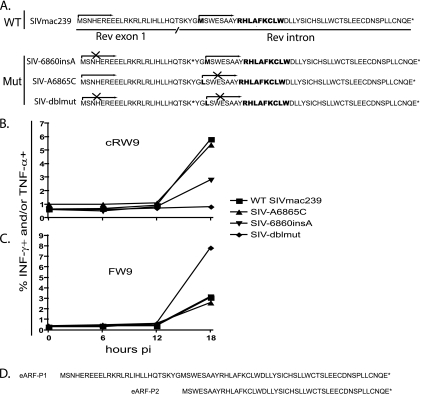FIG. 3.
cRW9 is produced as part of two distinct translation products. We created three mutant viruses to determine the start codon used to translate the cRW9 epitope (A). The first virus, SIV-6860insA (mutagenesis primers: 6860insA-F, GCATCAAACAAGTAAGTAATGGGATGTCTTGGGAATC, and 6860insA-R, GATTCCCAAGACATCCCATTACTTACTTGTTTGATGC), contains an inserted nucleotide which, when translated, introduced a stop codon in frame with cRW9, downstream of the rev splice donor site. This virus was used to test the hypothesis that translation of cRW9 occurred by translation from rev exon 1 into the intron. Another virus, SIV-A6865C (mutagenesis primers: A6865C-F, CAAGTAAGTATGGGCTGTCTTGGGAATCAG, and reverse, A6865C-R, CTGATTCCCAAGACAGCCCATACTTACTTG), mutated a potential methionine start codon in the rev intron to a leucine. This virus was used to test the hypothesis that translation of cRW9 occurred by initiation on this potential start codon. A third virus, SIV-dblmut (mutagenesis primers: dbl-F, GCATCAAACAAGTAAGTAATGGGCTGTCTTGGGAATC, and dbl-R, GATTCCCAAGACAGCCCATTACTTACTTGTTTGATGC), contained both of these mutations. It was used to test the hypothesis that both the rev start codon and the start codon within the rev intron were used to translate the cRW9 epitope. We then performed the KICS assay with CD4+ target cells infected with the different viruses (B and C). Data points represent the percentages of cells that are positive for gamma interferon (INF-γ) and/or tumor necrosis factor alpha (TNF-α) at each time point. SIV-6860insA and SIV-A6865C maintained the ability to present cRW9, but SIV-dblmut was not able to present the epitope at any time point tested. These results indicate that cRW9 is likely translated as part of two products, eARF-P1 and -P2 (D). The results depicted are characteristic of two separate assays. WT, wild type; Mut, mutant; pi, postinfection.

